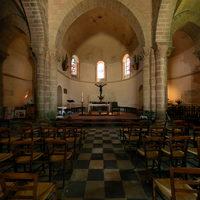Overview
One of the greatest Benedictine monasteries of the area, founded by Archambault II, called Le Montet (d. 1078) as a burial place for himself and his successors. Archambault III (d. 1095) added to the foundation. A magnificent new church was begun soon thereafter, intended to match the glory of Souvigny. This was an unusually well-funded construction of beautifully-finished ashlar masonry and ornate capitals that repeat themes found also at Souvigny, S-Menoux and S-Martin of Besson. The central vessel of the nave, covered by a pointed barrel vault (rebuilt) seems to have been increased in height during construction judging from the strip of wall above the cornice that surmounts the arcade. In its width and in the proportions of the bays and section of the piers the nave central vessel is remarkably similar to Besson. Aisles were vaulted with groin vaults replaced (except for the western bays) with rib vaults in the fifteenth century. To the east there was a spacious transept with chapels to the east and a choir with ambulatory and five radiating chapels (compare Chantelle). The church was modified in the fourteenth century when it was incorporated into the city wall and the north side of the nave was heightened with machicolations. In 1567 the church was badly damaged by the Protestants and the choir, heavily damaged, was subsequently razed. The present western frontispiece dates from the nineteenth century, as does the apsidal east end. The western tower is by the architect Jean-Baptiste Lassus.

